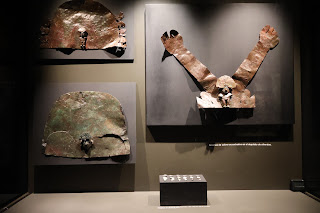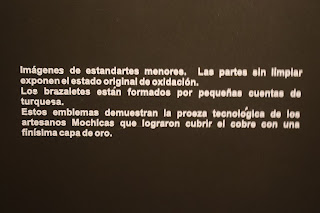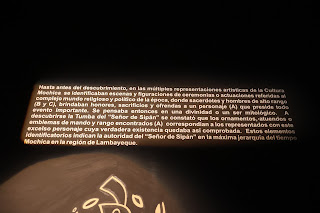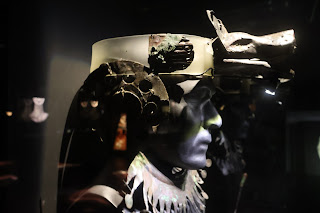Entering the second floor, there is a didactic presentation on the methodology
of archaeological excavations, the process of field research with the first
findings, then a repository of offerings with more than 1,137 vessels and
offerings that constituted the preamble to the Tombs of the Lord of Sipan.
Continuing the museographic sequence, one reaches the Tomb of the Lord of
Sipan, with the previous record of the guardian of the tomb and the ceiling of
the burial chamber, displayed based on images and reproductions taken from the
originals.
The center of the second floor is occupied by an open space on the floor,
which leads directly to the first floor, where the complete installation of an
exact reproduction of the Tomb of the Lord of Sipan is located, as it was seen
by archaeologists when it was unveiled. Here the visitor can appreciate the
careful arrangement of the central burial in its wooden coffin and the coffins
of the companions (three young women, the military chief, the standard bearer,
a child, the watchman, the guardian of the Tomb, two llamas and a dog).
The royal jewels and emblems of command are carefully displayed, among them
the three sets of ear ornaments stand out - the ear ornaments of the Lord of
Sipan, the ear ornaments of the deer and the ear ornaments of the
shoveler-billed duck - as well as various ornaments and most important emblems
of the Lord of Sipan such as the gold and silver scepter, the gold and silver
coxal protectors, two ritual rattles, the royal crown in a semilunar shape of
gold.
|
Plan of the second floor of the museum.
|
Beginning of the excavation
|
The work of the archaeologists
Recreation of a typical section of the Sipan constructions and the work
of the archaeologists.
|
First findings
|
Initial exploration and cleaning
During an initial exploration and cleaning, some ornaments and offerings
that had escaped the looting of the desecrators were recovered. They
were probably part of violently looted tombs.
- Center: Copper mask.
- Below: Breastplate of shell cutouts.
|
|
Copper crowns
Copper crowns found in the offering deposit.
|
The deposit of offerings
|
The deposit of offerings
By carefully cleaning the platform, an intact and sealed offering room
was discovered, from which 1,137 vessels, food remains, the skeleton of
a man, seashells and copper ornaments were gradually recovered.
-
This unprecedented find was a revealing clue for continuing the
investigation.
|
The Scepter
|
The most spectacular find
The most spectacular find in the looted tomb was a pointed, 1 m (3.3 ft)
long, 4 kg (8.8 lb) cast copper staff or sceptre, which ended in a 13 cm
square (2 in2) platform where a complex architectural structure was
depicted in the form of a temple with a high balustrade of four bodies
supported by posts and decorated with the heads of war clubs surrounding
a central platform where four pillars rest to support a gabled roof
exquisitely crowned by seventeen human heads with a headdress in the
form of two stepped horns or bristling snakes.
-
In the back panel, preceded by three steps, an icon represents a scene
of profound religious significance.
|
|
The copper scepter
-
The discovery of remains of ceramic images, similar to those
represented on the scepter, made it possible to confirm that the
temple had indeed existed in Sipan, and that the Mochicas decorated
the roofs of their sanctuaries or palaces.
|
|
Recreation of the temple
Recreation of the temple represented in the copper scepter, formed by a
balustrade with wooden posts, a central platform with a staircase and a
ceiling decorated with images.
|
|
Detail of the icon
Detail of the icon located on the main panel of the architectural
representation.
-
A woman represented as the Moon is possessed by the divinity,
symbolizing fertility or the creation of the world.
|
|
Clay headpiece
Clay headpiece found in the architectural fills of the Sipan Funerary
Platform.
-
It represents a human head with a curved and serrated headdress placed
in two parts, giving the appearance of horns.
-
This object is identical to the figures represented on a copper
scepter from Sipan with an architectural representation, proving the
existence of a temple or palace decorated with these objects.
|
The Tomb of the Lord of Sipan
|
The Tomb of the Lord of Sipan
|
|
The guardian of the tomb
Bones of the guardian of the tomb.
- Exact reproduction taken from the original.
|
|
Funerary wrapping
When removing the sediment from the inside of the coffin, the first
layer appears: a mass of copper objects covered in rust, some gold
ornaments and disintegrated textiles; they formed a funerary wrapping -
previously unknown - that kept the remains of the Lord of Sipan.
- On the sides are shells and sea snails.
|
|
The royal ornaments
At the beginning, beneath a lump of earth, the perfect, tiny golden face
emerged, breaking its centuries-long confinement and seeming to gaze at
us with its energetic gaze.
-
The small effigy is part of an ornament that would represent the Lord
himself.
|
|
The earmuffs
The earmuffs were ornaments of rank and royal symbols of the Lord of
Sipan, immediately being considered among the masterpieces of ancient
America.
-
Each jewel was made by assembling tiny pieces of laminated, embossed
and soldered gold with the application of turquoise inlays.
|
|
The second pair of earmuffs
The ornaments, apart from their extraordinary artistic quality and
refined technique, presented images and symbols that would help to
interpret this Royal burial and the Mochica world, reason for turning to
the representations of the pottery in comparison. The discovery began to
explain and reorder the knowledge of this culture.
-
The second pair of gold and turquoise mosaic earmuffs represented the
“spoon-billed” duck, a sacred bird associated with fertility.
-
In the scene of an important purification ceremony, the main character
wears similar ornaments. It was the first key to understanding the use
of these ornaments in specific rituals.
|
|
“Spoon-billed” duck earmuffs
|
|
Deer earmuffs
A third pair of earmuffs, made from embossed and openwork sheets of
gold, represent deer, animals sacrificed in ritual hunts and linked to
the cult of the dead.
|
|
The three sets of earmuffs
The three sets of earmuffs when they were discovered on either side of
the skull.
|
|
Recovering the ornaments
The original wooden supports and glues had disappeared and each piece
had to be stabilized.
-
A progressive piercing of the earlobe allowed these ornaments to be
attached.
|
|
The cleaned and restored gilded copper standard
It would represent a deity and also have a heraldic significance as the
emblem of the Lords of Sipan.
|
|
Parade using metal banners
Mochica representation of a parade using metal banners.
|
|
Sewing the metal pieces
The metal pieces of the banners were sewn onto a cotton cloth and
attached to a wooden pole using supports to carry them in ceremonies or
parades.
|
|
Images of minor banners
The uncleaned parts show the original state of oxidation.
- The bracelets are made of small turquoise beads.
-
These emblems demonstrate the technological prowess of the Mochica
artisans who managed to cover the copper with a very fine layer of
gold.
|
|
Conical ornaments
Mochica iconography showing how conical ornaments were used.
|
|
Conical gilded copper pendants
Conical gilded copper pendants also used to decorate headdresses.
|
|
Spondylus pectoral
The spondylus pectoral was stabilized to the extent that it was possible
to keep the beads in place.
- The original design would depict images of mythical animals.
|
|
Divinity crowned by mythological serpents
Cleaned and restored, the emblem would represent a dualistic symbol
where the headless silhouette, with open arms and hands, contains a
central divinity crowned by mythological serpents.
|
|
Nose rings and headdress
- Left: Gold nose rings used as a symbol of rank.
-
Right: Parts of a cotton headdress with metallic applications. It is
believed to represent a mythical animal. The embroidered angles allow
us to establish its surprising association with ritual races.
|
|
Runner with ritual headdress
Mochica representation of a runner wearing a similar ritual headdress.
|
|
Ornaments of the Lord
- Top left: Miniature combat weapons (clubs and shields).
-
Bottom left: Tweezers in gilded copper, used by Mochica men to shave
their beards.
- Top right: Restored shell breastplate.
-
Bottom right: Set of gold and silver nose rings that formed part of
the Lord's various ornaments.
|
|
Shell pectoral
Shell pectoral that would symbolize the “radiant” image of the Lord in
his condition of supreme authority.
- It was restored thanks to its careful recovery.
|
|
Necklace made of peanuts
Necklace made of peanuts in gold and silver, clean and restored.
-
It represents the concept of Mochica duality. Gold is associated with
the sun, day and masculinity; silver, with the moon, night and
femininity. The two forces of nature in balance that guarantee the
progress of the universe.
-
Peanuts are also linked to the cult of the dead and the permanent
return of the cycles of life.
|
|
Pectoral and ornaments
-
Left: Orange spondylus pectoral. Found above the peanut fruit collar.
-
Right: Ornaments and metal neck protectors (chinstraps) and discs that
formed part of combat attire.
|
|
Reproduction of the burial chamber of the Lord of Sipan
The burial chamber of the Lord of Sipan at the time of its discovery
(exact reproduction).
|
|
Reconstruction of the Funerary Chamber
Reconstruction of the Funerary Chamber of the Lord of Sipan, as it must
have looked 1700 years ago when he was buried in the coffin with his
ornaments, headdresses, emblems and attire, surrounded by 8 companions
and offerings.
-
At the foot and at the head, three women under 20 years old in their
cane coffins; to the right, a military chief with weapons and combat
attire; to the left, the standard bearer and a dog; in the corner, the
bones of a child.
-
Below, two llamas were the first animals sacrificed and placed at the
back of the enclosure. On the three sides of the chamber, a total of
five niches or niches were arranged with 212 vessels symbolically
arranged, containing offerings of food and drink.
-
Wooden beams covered the entire burial chamber. The guard soldier was
placed on a first layer of filler and in a side niche the body of a
lookout… It was the main entourage of the Lord and the offerings
carefully arranged for his journey to eternity.
|
|
Distribution of the components
Distribution of the components, companions and offerings of the burial
chamber.
|
|
Sceptre of gold and silver
A sceptre of gold and silver, a symbol of command and power.
-
The reliefs on the inverted pyramid depict a Lord in his combat attire
and weapons imposing himself upon a prisoner.
|
|
Coxal protector
Coxal protector with the representation of Ai-apaec or Decapitator,
supreme deity of life and death.
-
This important ritual ornament of gold was discovered for the first
time and was worn by the Lord hanging from the waist at the back.
|
|
Facial ornaments
The face of the lord was covered with funerary ornaments of gold, two
eyes, a nose with designs of the deity, a kind of cover with the
representation of all the teeth and finally, a thick protector for the
lower part of the face.
|
|
Ornaments with two similar faces
These gold ornaments have two similar faces and were made on a metal
sheet, which was drawn, pressed and folded.
|
|
Gold ritual rattle for the waist
Like similar ornaments, it had pieces of copper inside the spheres to
produce sound with movement.
|
|
The golden royal crown
When archaeologists discovered this important golden ornament, they were
finally able to confirm the highest status of the buried figure.
-
Never before had such an ornament been found, which only appeared on
the heads of semi-divine beings.
- It was the royal crown of the Lord of Sipan.
|
|
Scene interpretation
Before the discovery, in the multiple artistic representations of the
Moche culture, scenes and representations of ceremonies or performances
referring to the complex religious and political world of the time were
identified, where priests and high-ranking men (B and C), offered
honors, sacrifices and offerings to a character (A) who presided over
every important event. At that time, it was thought of as a divinity or
a mythological being.
-
When the Tomb of the “Lord of Sipán” was discovered, it was found that
the ornaments, attire or emblems of command and rank found (A)
corresponded to those represented with this exalted character whose
true existence was thus proven. These identifying elements indicate
the authority of the “Lord of Sipán” in the highest hierarchy of the
Moche time in the Lambayeque region.
|
|
Sandals, case and flaps
-
Left: Silver sandals, worn by the Lord as a sign of his semi-divine
status.
- Center: Part of a copper case or sheath depicting an owl.
- Right: Double-sided head-shaped copper flaps.
|
|
Necklace, knife and snake heads
- Left: Necklace made of gold spheres made using soldered covers.
-
Center top: Gold and silver knife found on the chest bones, symbolizes
duality.
-
Center bottom: Copper snake heads that topped the Lord's belt. An
important symbol that identifies him with the divinity of snakes.
- Right: Silver realistic heads necklace.
|
|
Detail of the silver realistic heads necklace
|
|
Headdress appendages
-
Left: Copper bars for holding feather headdresses made of plant
fibers.
-
Center: Remains of plant fibers where the feathers of headdresses were
originally tied.
-
Right: Small metal rattles that were worn attached to the appendages
of the showy headdresses.
|
|
Another shell pectoral
Another of the shell pectorals that was part of the Lord's attire.
|
|
Ocarina, arrows or darts, and fabric scraps
- Left: Copper ocarina depicting a frog.
-
Center: Copper arrow or dart tips. Attached to wood, they were used
for combat or hunting.
-
Right: Only a few fragments of the clothing, wrappings and textiles
remained, reflecting various techniques and complex designs.
|
|
Fox head for the helmet
Fox head for the helmet, chin strap and protective discs that formed the
Lord's military attire.
|
|
Solid silver scepter
Solid silver scepter, also representing a Lord imposing himself
militarily over a prisoner.
|
|
The funeral of the “Lord of Sipan”
…1,700 years ago a grieving crowd accompanied the funeral of the “Lord
of Sipan” who lay wrapped in a bundle of cloth and metals… the ceremony
was presided over by a new Lord, priests and military chiefs…. escorts
of warriors with weapons, banners and trophies, musicians with drums and
trumpets, clamoring women and all the anguished subjects were present…
the prolonged collective mourning and the complex preparations of
rituals and offerings, came to an end… the Lord and his 8 companions
would be buried for their journey to eternity…
|
The Priest
|
Crown and vessel
- Top: Copper crown found on the guardian's bones.
-
Bottom: Vessel for liquid offerings, placed in the character's hand.
|
|
Vessel for liquid offerings
Vessel for liquid offerings, placed in the character's hand.
|
|
Vessels for food and drink
Representative vessels that originally contained food and drink.
- They were placed in the niches of the burial chamber.
|
|
The skeletal remains of the Priest
The skeletal remains of the Priest and some offering vessels.
|
|
The burial chamber
The main coffin was placed in the centre of the burial chamber, with two
young women on either side; one of them was the main wife, the other
apparently sacrificed at the time of burial.
- A man was the third companion.
- A child lay in the company of a dog and a snake.
- A decapitated llama was placed in the corner.
-
In the niches were placed about fifty vessels for food offerings.
|
|
Reconstruction of the funerary trousseau
When the archaeologists finished recording this burial, they found that
it was the Priest, represented in Moche art as the "bird man."
- Another important discovery for understanding this culture.
|
|
Ear cuffs and nose rings
-
Top: Set of gilded copper, gold and turquoise ear cuffs, worn by the
Priest.
-
Center: Part of a gold nose ring with warrior designs. The other half
was disintegrated.
-
Bottom: Gold nose ring. Two engraved combat batons decorate its inner
side.
|
|
Objects recovered from the priest's tomb
-
Left: Silver-plated copper figurine, representing the "owl man",
recovered from the priest's tomb.
- Center: Gilded copper bowl.
-
Right: Gilded copper figurine, representing anthropomorphized club.
|
|
Necklace of death
Metal necklace depicting faces in deathly grimaces.
-
One of the heads, uncleaned and unrestored, shows how they were found.
|
|
Necklace of life
Gold-plated copper necklace, depicting smiling faces that symbolize
life.
- The teeth are made of shell inscriptions.
|
|
Breastplate, coxal protector and rattle
-
Left: One of the breastplates worn by the Priest, partially restored.
-
Top right: Gold and silver coxal protector, worked in two riveted
metal sheets.
- Bottom right: Copper rattle, for headwear.
|
|
Reconstructed image of the Priest
Reconstructed image of the Priest with his headdresses, ornaments and
ceremonial utensils.
-
The owl crown and the cup identify him as the person in charge of
religion and worship.
-
In Mochica society he occupied the place immediately after the Lord.
|
See also
Source
Location
Royal Tombs of Sipan Museum
Royal Tombs of Sipan Museum - Third Floor
Royal Tombs of Sipan Museum - First Floor


































































































































